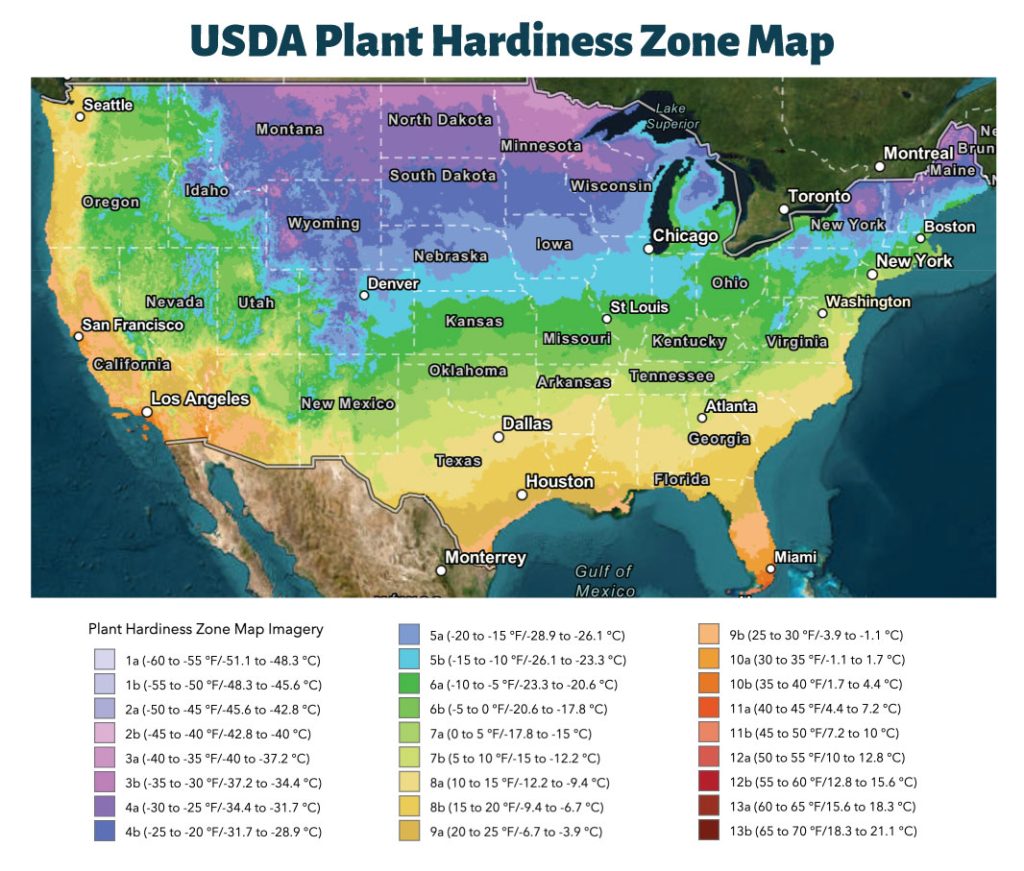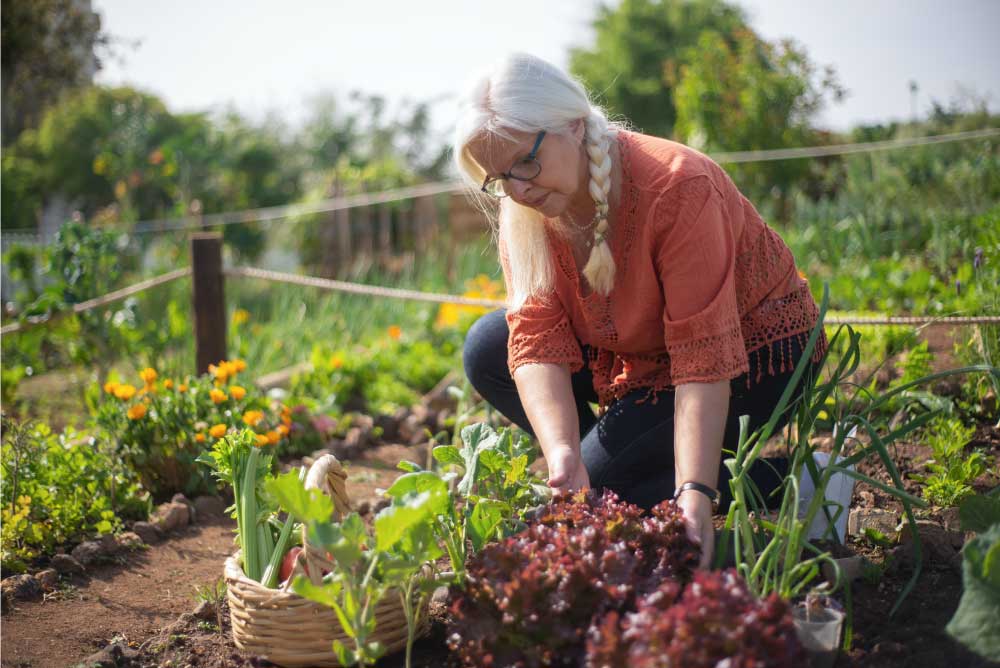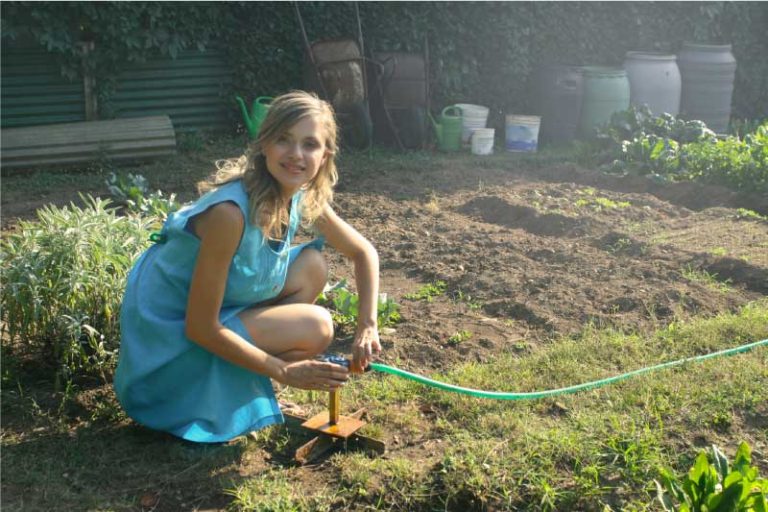USDA Plant Hardiness Growing Zone Map
If you’re into gardening or any of the other agriculture-related hobbies, it’s important to understand how the climate in the area where you’re planting will affect whatever it is you’re intending to grow.
Fortunately, you don’t have to waste your time testing out different plants to see if they can survive the climate where you live. The United States Department of Agriculture (or USDA) publishes what they call the USDA Plant Hardiness Zone Map for growing plants, trees, and other things. The USDA first published their Plant Hardiness Zone Map in 1960 based upon weather data they had collected during the 1930s through the 1950s. In 1990, the USDA updated the map to include Alaska and Hawaii, and divided the zones into 5°F increments instead of 10°F increments. In 2012, the USDA released an updated version of the map based on the latest data from the 30-year period from 1976 to 2005. This version was more detailed, with 13 zones instead of 10, and used more advanced technology to create a more accurate representation of the hardiness zones in North America. In 2016, the USDA published a digital version of the map that allows users to search for their specific location and view their hardiness zone.
The official USDA Plant Hardiness Zone Map is published on the USDA website.
The current USDA Plant Hardiness Zone Map is created using average annual minimum winter temperatures, which are measured over a 30-year period. The minimum temperature data is collected by the National Climatic Data Center and is based on observations taken at weather stations throughout North America. The zones are then divided based on 10°F increments, which reflects the average minimum temperature a plant can survive in a given area. The USDA uses this data to determine the cold hardiness of plants and to help gardeners, horticulturists, and agriculturalists determine which plants are most likely to thrive in different regions of the country. The USDA regularly updates the Plant Hardiness Zone Map to account for changes in the climate and to provide the most accurate information possible.

The USDA Plant Hardiness Zone Map is currently divided into 13 zones that take into account the changing climate and average minimum winter temperatures in North America. Here is a brief explanation of the 13 zones and some examples of common plants that will grow in each:
| USDA Hardiness Zone | Avg Min Temp Range | Geographical Region | What Can Grow There |
|---|---|---|---|
| Zone 1a | -60°F to -55°F | Alaska, Northern Canada | Only the hardiest plants like arctic willows, arctic poppies, and sedges can grow in this zone. |
| Zone 1b | -55°F to -50°F | Alaska, Northern Canada | Plants that can grow in this zone are very limited, including only the most cold-hardy species such as arctic cotton and arctic moss. |
| Zone 2a | -50°F to -45°F | Alaska, Northern Canada | Plants like willows, birches, and spruces can grow in this zone, as well as some fruit trees like apples and cherries with winter protection. |
| Zone 2b | -45°F to -40°F | Alaska, Northern Canada | In addition to the plants from zone 2a, zone 2b can also support perennials like peonies, iris, and lilies, as well as some vegetable crops like garlic and rhubarb. |
| Zone 3a | -40°F to -35°F | Central and Southern Plains, Midwest, Great Lakes | This zone is suitable for a wide variety of plants, including shade trees like oaks and maples, ornamental shrubs like roses and hydrangeas, and vegetables like tomatoes and peppers. |
| Zone 3b | -35°F to -30°F | Central and Southern Plains, Midwest, Great Lakes | In addition to the plants from zone 3a, zone 3b can support even more types of plants, including some subtropical species like citrus and avocados with winter protection. |
| Zone 4a | -30°F to -25°F | Central and Southern Plains, Midwest, Great Lakes | Fruit trees like apples, cherries, and peaches (with winter protection); Perennials like daylilies, hostas, and black-eyed Susans; Shrubs like hydrangeas, roses, and rhododendrons; Annuals like marigolds, petunias, and impatiens; Vegetables like tomatoes, peppers, and green beans |
| Zone 4b | -25°F to -20°F | Central and Southern Plains, Midwest, Great Lakes | In addition to the plants that grow well in zone 4a, zone 4b can also support some subtropical plants with winter protection, such as citrus and avocados. |
| Zone 5a | -20°F to -15°F | Midwest, Great Lakes, Mid-Atlantic | Fruit trees like apples, cherries, peaches, plums, and figs; Perennials like daylilies, hostas, black-eyed Susans, lavender, and irises; Shrubs like hydrangeas, roses, rhododendrons, viburnums, and butterfly bushes; Annuals like marigolds, petunias, impatiens, and geraniums; Vegetables like tomatoes, peppers, green beans, summer squash, and pumpkins In addition to the plants that grow well in zones 4a and 4b, zone 5a can also support some tropical and subtropical plants, such as bananas and papayas, with winter protection. |
| Zone 5b | -15°F to -10°F | Midwest, Great Lakes, Mid-Atlantic | In addition to the plants that grow well in zones 4a, 4b, and 5a, zone 5b can also support some tender tropical and subtropical plants, such as hibiscus and bougainvillea, with winter protection. |
| Zone 6a | -10°F to -5°F | Mid-Atlantic, Midwest | Fruit trees like apples, cherries, peaches, plums, figs, citrus (with winter protection), and pears Perennials like daylilies, hostas, black-eyed Susans, lavender, irises, daffodils, and tulips Shrubs like hydrangeas, roses, rhododendrons, viburnums, butterfly bushes, blueberries, and raspberries Annuals like marigolds, petunias, impatiens, geraniums, and zinnias, as well as herbs like basil and oregano Vegetables like tomatoes, peppers, green beans, summer squash, pumpkins, carrots, and cucumbers In addition to the plants that grow well in zones 5a and 5b, zone 6a can also support many deciduous and evergreen trees like oak, maple, and pine, as well as tender tropical and subtropical plants like hibiscus, bougainvillea, and mandevilla, with winter protection. |
| Zone 6b | -5°F to 0°F | Mid-Atlantic, Midwest | In addition to the plants that grow well in zones 5b, and 6a, zone 6b can also support many deciduous and evergreen trees like oak, maple, pine, and magnolia, as well as tender tropical and subtropical plants like hibiscus, bougainvillea, and mandevilla, with winter protection. |
| Zone 7a | 0°F to 5°F | Mid-Atlantic | Fruit trees like apples, peaches, plums, figs, citrus (with winter protection), and pears Perennials like daylilies, hostas, black-eyed Susans, lavender, irises, daffodils, tulips, and phlox Shrubs like hydrangeas, roses, rhododendrons, viburnums, butterfly bushes, blueberries, raspberries, and blackberries Annuals like marigolds, petunias, impatiens, geraniums, zinnias, as well as herbs like basil and oregano Vegetables like tomatoes, peppers, green beans, summer squash, pumpkins, carrots, cucumbers, and melons In addition to the plants that grow well in zones 6b, zone 7a can also support many deciduous and evergreen trees like oak, maple, pine, and magnolia, as well as tender tropical and subtropical plants like hibiscus, bougainvillea, and mandevilla, with winter protection. |
| Zone 7b | 5°F to 10°F | Mid-Atlantic | In addition to the plants that grow well in zones 6b and 7a, zone 7b can also support many deciduous and evergreen trees like oak, maple, pine, and magnolia, as well as tender tropical and subtropical plants like hibiscus, bougainvillea, and mandevilla, with winter protection. |
| Zone 8a | 10°F to 15°F | Mid-Atlantic, South | Fruit trees like oranges, lemons, limes, kiwi, and avocados Perennials like dahlias, gerberas, coneflowers, coreopsis, bee balm, irises, canna lilies, and lantanas Shrubs like hibiscus, bougainvillea, roses, butterfly bushes, camellias, and gardenias Annuals like petunias, impatiens, zinnias, marigolds, and sunflowers Vegetables like tomatoes, peppers, corn, green beans, okra, and eggplants Zone 8a can also support many subtropical and tropical plants like bananas, passion fruit, and papayas, as well as deciduous and evergreen trees like live oaks, magnolias, and southern pines. |
| Zone 8b | 15°F to 20°F | South | Fruit trees like figs, peaches, nectarines, and persimmons Perennials like jasmine, bromeliads, hibiscus, and ginger lilies Shrubs like gardenias, camellias, and holly Annuals like petunias, impatiens, and marigolds Vegetables like tomatoes, peppers, corn, green beans, and eggplants Zone 8b can also support many subtropical and tropical plants like mangoes, papayas, and bird of paradise, as well as deciduous and evergreen trees like live oaks, magnolias, and southern pines. |
| Zone 9a | 20°F to 25°F | South | Citrus trees like oranges, lemons, and limes Palms like coconut, date, and fan palms Succulents like agave, aloe, and cacti Bougainvillea, hibiscus, and bougainvillea Vegetables like tomatoes, eggplants, cucumbers, and squash In addition, many subtropical and tropical plants like bananas, papayas, and ginger thrive in this zone, as well as evergreen and deciduous trees like magnolias, live oaks, and southern pines. |
| Zone 9b | 25°F to 30°F | South | Some warm-season crops like okra, sweet potatoes, and cowpeas, may do better in Zone 9b compared to Zone 9a. Additionally, plants that are at the edge of their hardiness range in Zone 9a may perform better in Zone 9b. |
| Zone 10a | 30°F to 35°F | South | Citrus trees such as lemon, orange, and grapefruit Avocado trees Palms such as king palm, queen palm, and sago palm Bougainvillea, Hibiscus, Clivia, Jasmine, Gardenia, Brugmansia Bougainvillea, Plumeria |
| Zone 10b | 35°F to 40°F | South | Bougainvillea, Hibiscus, Clivia Jasmine, Gardenia, Brugmansia, Bou Gainvillea, Plumeria, Bananas, Papayas, Mangos, Guavas, Starfruit Some plants that grow well in Zone 10a may struggle in Zone 10b due to the hot and humid conditions. |
| Zone 11a | 40°F to 45°F | South | Same as 10b Other common crops in this zone include avocado, coconut, coffee, and oranges |
| Zone 11b | 45°F to 50°F | South | Tropical and subtropical plants such as banana trees, bird of paradise, hibiscus, and bougainvillea |
| Zone 12a | 50°F to 55°F | South | Palms such as coconut, royal, and date Bougainvillea, Hibiscus, Frangipani, Birds of Paradise, Bamboo, Alocasia, Yucca |
| Zone 12b | 55°F to 60°F | South | Bougainvillea, Bird of Paradise Hibiscus, Mandevilla, Plumerias Crotons, Banana Trees, Bismark Palms |
| Zone 13a | 60°F to 65°F | South | Bougainvillaea, Hibiscus, Bird of Paradise, Oleanders, Royal Palms, Sago Palm, Starfruit, Sugar Apple, Ti Plants These plants may require protection from extreme heat and drought, and may not perform as well in the harshest climates within the zone. |
| Zone 13b | 65°F to 70°F | South | Cacti, succulents, bougainvillea, agave, and various types of palm trees. Plants that are more heat-tolerant and drought-resistant may be better suited for growing in zone 13b. |
It is important to note that while the USDA Hardiness Zone Map is a useful tool, there are many other factors that can impact the success of a plant, such as soil type, sunlight, moisture, and local microclimates. Gardeners should use the map as a starting point, but also consider other factors when selecting plants for their garden.


